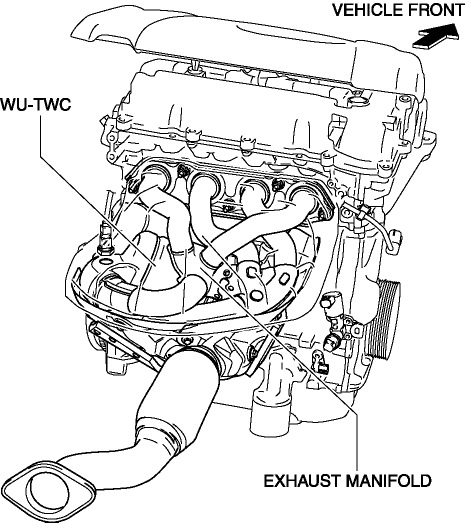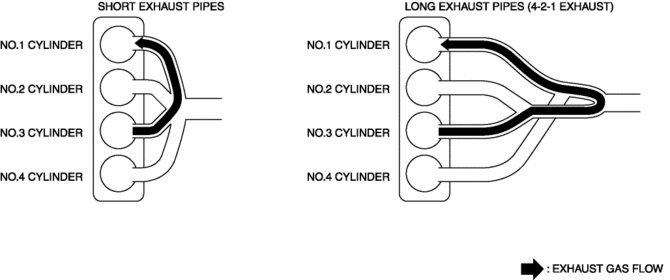Mazda CX-5 Service & Repair Manual: Exhaust Manifold
Purpose, Function
-
By lengthening the exhaust passage, the transmission of exhaust pressure waves to other cylinders can be delayed, and the amount of gas exhausted from a cylinder and forced back inside the combustion chamber is reduced By reducing the residual gas, the temperature inside the combustion chamber is reduced and the occurrence of knocking even at a high compression ratio is inhibited.
Construction
-
The exhaust manifold is installed to the rear of the engine. In addition, the catalytic converter (WU-TWC) is integrated (WU-TWC).

-
When the No.1 cylinder is at the intake stroke, the No.3 cylinder is at the exhaust stroke. By inducing the high temperature gas exhausted from the No.3 cylinder into the No.1 cylinder, the high temperature gas in the No.1 cylinder remains. If the amount of residual gas is high, the temperature in the combustion chamber rises and knocking can easily occur. With the 4-2-1 exhaust system, the transmission of exhaust pressure waves between each cylinder is delayed by the long exhaust pipes.

 Exhaust System Removal/Installation
Exhaust System Removal/Installation
WARNING:
A hot engine and exhaust system can cause severe burns. Turn off the engine
and wait until they are cool before removing the exhaust system.
2WD
1. Disconnect the negative b ...
Other materials:
Fuel Pressure Sensor Inspection
Voltage Inspection
NOTE:
The fuel pressure sensor cannot be removed as a single unit. When replacing
the fuel pressure sensor, replace it together with the fuel distributor as a
single unit.
1. Connect the M-MDS to the DLC?2.
2. Switch the ignition ON (engine off or on).
3. ...
Air Mix Actuator Inspection [Full Auto Air Conditioner]
CAUTION:
If the lever position exceeds the operation range shown in the figure, the
circuit in the actuator could be damaged. Always perform an actuator operation
inspection with the lever movement within the range shown in the figure.
Driver-side
1. Connect battery positive vol ...
Rear Upper Arm Removal/Installation [Awd]
WARNING:
Verify that the crossmember is securely supported by a jack. If the rear
crossmember falls off, it can cause serious injury or death, and damage to the
vehicle.
CAUTION:
Performing the following procedures without first removing the rear ABS wheel-speed
...

